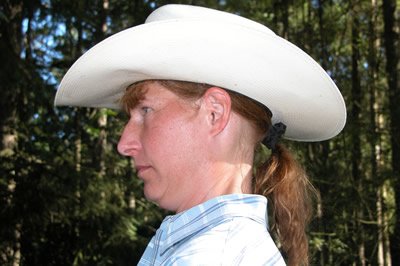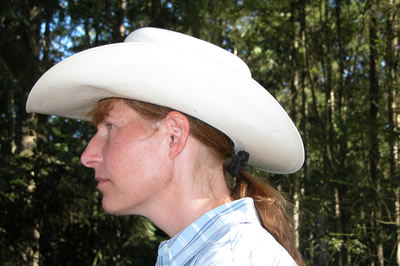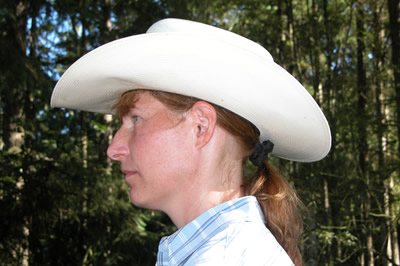Do you have trouble looking where you are going? Does your neck get tense when your ride or become stiff afterward? Do you have difficulty sitting the trot? The solution may be all in your head. Here’s a quick tip for finding a good comfortable head position.

Next time your ride pay attention to your head, that 10 – 15 lb bowling ball at the top of your neck. That’s right, your head weighs as much as a bowling ball and you are carrying this weight around all the time. If your head is poorly balanced your neck and back muscles have to work hard to keep from dropping the ball.
To state the obvious, your head contains most of your sensory organs; eyes, ears, nose and mouth. You might be able to feel all over your body but you can’t take in food through your toes. Your head also contains your brain. A major function of the brain is to receive input regarding your balance, then make appropriate adjustments so you can stand, walk, run and ride.
For most of us this balancing act goes on behind the scenes without ever noticing it. Our nervous system constantly monitors where we are in space and makes sure we don’t succumb to gravity. Carrying a 10 lb bowling ball approximately 5 – 6’ above the ground isn’t easy. It certainly requires a lot of internal attention to keep it there.
The horse’s head also contains most of his senses; eyes, ears, mouth and nose in addition the brain. His head weighs about 4% of his overall body weight. In a 1000 lb horse that is 40 lbs. The horse’s head hangs out from the neck, which makes balancing it a lot harder than balancing your head. To sense of how much effort is required, grab a gallon of milk. Hold it horizontally away from your body at arms length. I guarantee you aren’t going to keep it there very long! Fortunately the horse is designed to carry the weight of his head in this position.

In both horses and humans protecting the head is so important that the nervous system will spend a lot of time making sure it doesn’t hit the ground. Poor head carriage requires more attention than good head carriage, and distracts the nervous system from doing other things like focusing on the next jump. In addition, habitually carrying the head forward or back (the equivalent of high or overly tucked in the horse) requires a lot of muscular effort and inhibits other movements such as turning the head.

Good head alignment means that you use a minimum amount of muscular effort to hold up your head, allowing the skeleton to do most of the work. When your head is well-aligned front to back, you can lengthen through your spine all the way through the top of your head, thereby countering the downward force of gravity. If your head is pulled back or jutted forward the force gravity will press down making you heavier on the horse’s back.
To find a good position for your head gently turn your head side to side as you move it forward and back. Find the place where your head turns most freely. Stop turning and notice that you will breathe easier when your head is balanced. See if you can lengthen your neck so that the head moves slightly upward. To lengthen your neck think of pricking your ears as if you were a horse.
Use this Murdoch Minute as a body position ‘self-check’ to balance your head. When your head is well balanced you can support it with less tension, easily look for your turns and move more freely with your horse’s motion. Whenever you feel stuck simply take a second to repeat the process of balancing your head to free your whole body. And remember – enjoy the ride!
Wendy Murdoch resides in Washington, VA and is an international riding instructor/clinician. She travels worldwide teaching riders of all levels and disciplines how to improve the horse’s performance by improving their body position.




